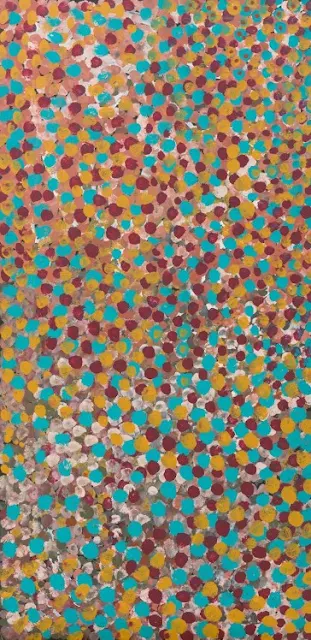A Journey Through Time, Culture, and Expression
Contemporary Aboriginal art is a captivating and profound form of expression that transcends aesthetic appeal, serving as a bridge between ancient traditions and the modern world. Rooted in the rich history of Australia’s Indigenous peoples, this art form resonates with the stories of ancestors while dynamically engaging with contemporary themes and mediums. It offers a powerful lens to explore cultural identity, environmental stewardship, and global issues, making it an integral part of the artistic and cultural landscape.
Trailblazing Figures and Their Impact
A discussion of contemporary Aboriginal art would be incomplete without acknowledging the monumental influence of Albert Namatjira. A pioneer in Indigenous Australian art, Namatjira introduced the world to the beauty of the Western Arrernte landscapes through his evocative watercolor paintings. His success broke barriers, inspiring generations of Indigenous artists to pursue creative expression while honoring their cultural heritage.
 |
| Albert Namatjira - Mount Giles, MacDonnell Ranges, Central Australia |
Following his legacy, Emily Kame Kngwarreye emerged as one of Australia’s most celebrated artists, achieving international acclaim for her bold, expressive use of color and form. Her works, deeply rooted in her connection to the land and her people’s stories, redefined the possibilities of Aboriginal art, proving its place on the global stage.
 |
| Emily Kame Kngwarreye - Yam Seed |
Equally significant is Rover Thomas, whose earthy tones and minimalist compositions have become iconic representations of the Kimberley region and its stories. His work not only brought attention to Aboriginal art but also earned a place at prestigious exhibitions, including the Venice Biennale.
 |
| Rover Thomas - Bedford Station |
Challenging Perspectives Through Modern Expression
In more recent times, artists like Gordon Bennett and Tracey Moffatt have pushed the boundaries of Aboriginal art, infusing it with sharp social commentary and innovative techniques. Bennett’s work, characterized by its fusion of Western art styles with Aboriginal iconography, delves into themes of cultural identity, colonialism, and the post-colonial experience. His bold and often provocative pieces challenge viewers to reconsider Australia’s history and its lingering effects on Indigenous communities.
 |
| Gordon Bennett - Colonist |
Moffatt, renowned for her photography and film, explores complex narratives surrounding race, gender, and identity. Her cinematic storytelling and visually arresting compositions position her as one of Australia’s most influential contemporary artists.
 |
| Tracey Moffatt - Up in the sky 4 |
Sculpture, Installation, and the Expansion of Aboriginal Art
The influence of Aboriginal art extends beyond painting into sculpture and installation.
 |
| Fiona Foley - Interwoven Paths |
Fiona Foley’s thought-provoking works address themes of history, race, and politics, compelling audiences to confront uncomfortable truths. Similarly, Doreen Reid Nakamarra’s intricate paintings explore traditional Pintupi stories with a modern sensibility, employing visual depth and texture to evoke the vastness of the Western Desert.
 |
| Doreen Reid Nakamarra - Untitled |
The Papunya Tula Movement and Its Legacy
A cornerstone of contemporary Aboriginal art is the Papunya Tula movement, which began in the 1970s in a small community northwest of Alice Springs. This movement marked the transformation of ancient cultural expressions into modern acrylic paintings, starting with the groundbreaking "Honey Ant Dreaming" by Kaapa Tjampitjinpa. The Papunya Tula collective not only revolutionized Aboriginal art but also empowered communities across Australia to share their cultural heritage with the world.
Bringing Aboriginal Art to the World
The impact of Aboriginal art is celebrated on both national and international stages. Exhibitions at institutions like the Museum of Contemporary Art in Sydney and the National Gallery of Australia, along with global expositions, have amplified the voices of Aboriginal artists. Their works create dialogues that bridge cultural divides and foster greater understanding and respect.
A Testament to Resilience and Creativity
Contemporary Aboriginal art is far more than an artistic movement; it is a vibrant political statement, a form of cultural preservation, and a celebration of resilience. It stands as a testament to the strength and creativity of Australia’s Indigenous peoples, reflecting their enduring connection to the land and their unyielding spirit in the face of adversity.
As we admire the breathtaking beauty of these artworks, we are invited to delve deeper into the narratives they embody, stories of survival, celebration, and the intricate relationship between culture and environment. Contemporary Aboriginal art continues to inspire and challenge us, reminding us of the enduring power of creativity to heal, unite, and transform.



.jpg)







No comments:
Post a Comment